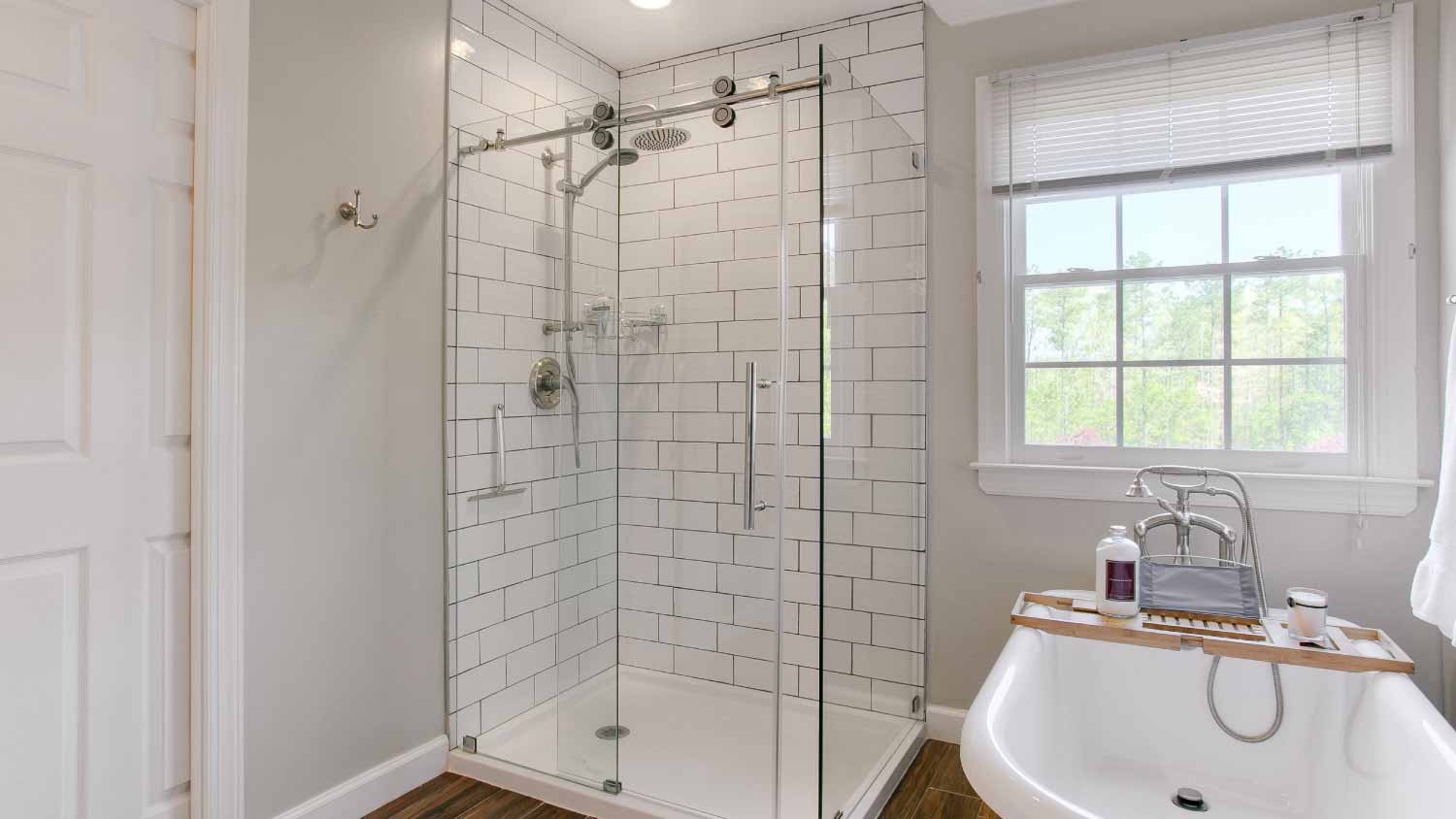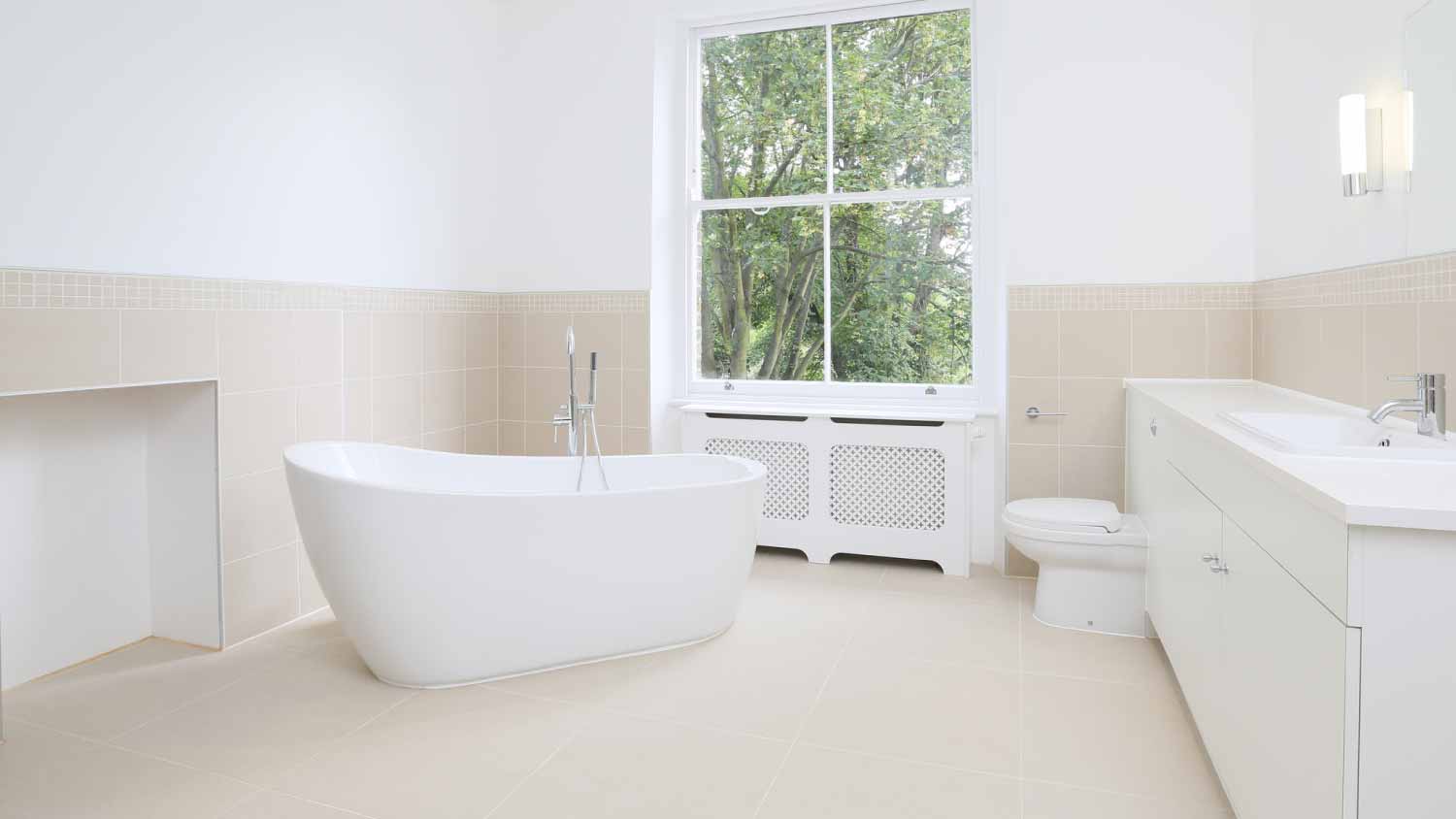
Bathtub refinishing costs are relatively inexpensive and can make your bathroom look like new. Our guide gives you the information to learn more about this process.
The perfect tub can become the crown jewel of your bathroom


If you’re in the beginning stages of a bathroom remodel, you’re probably already realizing how many choices you have to make. From choosing the right flooring to vanities to faucets and knobs, there are what feels like a million details to nail down. One of the most important (and possibly challenging) will be choosing the right bathtub. Gone are the days of having only standard rectangle wall units available to install. Tubs are now available in a huge range of sizes, shapes, materials, and price points. Narrowing down your choice will be easier after answering these questions.
A standard bathtub length is 60 inches, with a width of 32 inches and a height of 18 inches. While those dimensions may work perfectly for your space, there are both larger and smaller options available. Older homes may have a tighter layout, so a more compact tub might be necessary. Taller bathers may prefer a roomier tub that allows them to stretch out and soak comfortably.
Alcove is a common installation style where the tub is tucked into a recess in the bathroom, such as in a corner or along a wall. It’s designed to save space, as it usually sits in the center of three joining walls. Alcove tubs are frequently installed as part of a bathtub-to-shower conversion, creating a single-unit combination. Freestanding bathtubs don't rely on any walls or corners, and therefore take up a larger footprint in the bathroom. If you have the space for one, freestanding tubs can offer another level of style and comfort not always available with an alcove installation. Be warned that this bathroom remodel cost is a luxury that comes with a heftier price tag.
No longer only available as off-white, plastic rectangles, you can now find bathtubs in a variety of shapes, colors, and materials. Before deciding on a style, you will need to take several factors into consideration:
Reinforced plastic (such as acrylic or fiberglass), cast iron, porcelain enamel, and cast polymer are all options for bathtub materials. When choosing one, you will need to look at durability, price, how easy it is to clean, and how each will fit the overall aesthetic of the rest of the room. (More on this in a moment).
While an enameled cast iron, claw-footed soaking tub sounds wonderful, you’ll need to make sure your flooring can support such a heavy piece. And though a fiberglass bathtub is lighter, if you choose an extra-large model that also has jets, you may need to reinforce it with some extra support before installation. A local bathtub installation pro can help you better assess your specific needs.
Tubs come in shapes like corner, round, square, slipper, oval, rectangle, and hourglass these days. To choose the right one, you’ll need to consider both its size and what will work best in your bathroom. Also, think about the desired depth. While the standard 16-inch to 36-inch models may be plenty, if you are hoping for a more immersive experience, depths of more than 40 inches are available.
Much like a mattress, it’s nearly impossible to guess how a bathtub will feel unless you try it out. Investing in a tub that isn’t comfortable will be a waste, so go ahead and hop in a few at the store.

Your bathtub material is one of the first things you’ll notice about your tub, so if appearances are important, you’ll want to give this aspect a lot of consideration. However, the bathtub material will affect a lot more than meets the eye.
Pros: This material type is popular because it’s relatively affordable and fairly durable. It’s also in the middle-ground for weight, so you can likely put it on your second floor with little problems (though you’ll want to double-check the weight limitations of your bathroom).
Cons: You’ll be limited on style and color options if you choose this material, so if you’re looking for something unique, you may run into issues. Insulation may also be an issue here, so if you’re a fan of chilling out in the bath for hours, another option may suit you better.
Pros: Fiberglass has many benefits as a material, including being affordable and straightforward to install. It’s also pretty easy to maintain and is fairly lightweight.
Cons: However, these positives come with some cons. It’s not as durable as many of the other options on our list and requires a bit more upkeep. You’ll be paying a low cost upfront, yes, but you may need to pay for more work down the road. This material also has relatively few color options, so take that into account.
Pros: This tub material is another relatively affordable and lightweight option. One of its biggest benefits is the wide range of colors and styles you can choose from, so this could be best for you if you’re looking to nail down a very specific look.
Cons: Acrylic is a bit more expensive than fiberglass, though, and will need to be reinforced in some spots. However, one of the biggest things to keep in mind with this material is its care: You’ll have to be careful not to use abrasive cleaners when cleaning your acrylic tub, as these can cause damage.
Pros: If you’re looking for a tub to last through the ages, enameled cast iron is probably your best bet. This material is durable and won’t chip or scratch very easily. It will also keep your baths nice and toasty for a longer time than many other options.
Cons: But when it comes to cast iron’s biggest drawback, it’s the weight. These tubs are extremely heavy, so you may not be able to install one on your second floor. It’s best to speak with your contractor before getting your heart set on an option so they can explain what your weight limitations might be.
Pros: This type of tub is another attractive option for those who want a variety of color and style options. If you’re not a fan of scrubbing your tub, you may want to choose this material, as it’s fairly resistant to stains and pretty easy to clean generally.
Cons: However, cast polymer may not be the most comfortable option, as it tends to be brittle, so if that matters a lot to you, go with another material type. It can also be fairly pricey, so be sure to shop around.
When choosing the style and depth, you’ll need to consider who will be using the bathtub most often. A non-stick bottom is helpful for anyone when bathing. For children or older adults, you’ll want to consider adding grab bars for stability. In addition, choosing an ADA-compliant walk-in bathtub may be beneficial in making the tub accessible.
Before you install the new tub and enjoy that first soak, don’t forget to plan for appropriate storage. An alcove-style tub typically allows enough space to include shelving in the surround or corner. Freestanding tubs will likely need extra components, such as floating shelves, baskets, or an over-the-tub caddy.
While bathroom remodels may take a while (six weeks is usually the minimum), the good news is that it’s a home project with a huge ROI.
If you’re having trouble deciding on the style of tub, don’t forget to ask your contractor for their bathroom remodel design insights. They’ll often have tips and advice you may not have considered.
Once you’ve made plans and the installation is complete, you’ll be soaking in your new bathtub and wondering how you ever lived without it.
From average costs to expert advice, get all the answers you need to get your job done.

Bathtub refinishing costs are relatively inexpensive and can make your bathroom look like new. Our guide gives you the information to learn more about this process.

Find out how much it costs to refinish your porcelain sink and the factors that influence the final price to make it look like new, including size, type, and labor.

If you’re installing or replacing your shower doors, you’ll be working with a glass installation pro. Here are the most common shower door questions for this project.

If you're looking for an economical way to spruce up your bath or kitchen, here are the bathtub refinishing questions you should be asking a contractor.

There’s really only one solution when the finish starts to peel off. We’ll show the reasons why your bathtub is peeling and how to fix it.

Acrylic bathtubs are a common go-to, but are they right for your bathroom remodel? This guide breaks down the pros and cons of acrylic tubs.